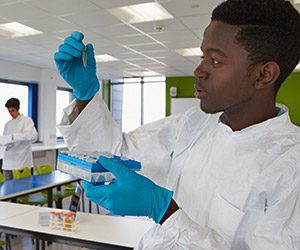There has been a growing interest across the U.S. in expanding science, technology, engineering and math (STEM) opportunities for our nation’s youth through STEM-focused high schools – particularly for those groups who are under-represented in these high-growth fields (including minorities, females, and students from low-income families). Inclusive STEM high schools are designed to increase participation of under-represented students by admitting students on the basis of interest, rather than test scores or prior achievement. As inclusive STEM high schools gain more traction, it’s imperative to understand not only how to design and implement these innovative schools, but also to gain insights into their impact on student achievement.
Key to this understanding is the ability to identify and define the characteristics of successful inclusive STEM high schools. To this end, researchers from SRI Education, George Washington University (GWU) and George Mason University collaborated on the Opportunity Structures for Preparation and Inspiration (OSPrI) study, funded by the National Science Foundation.

Over the course of five years, researchers studied eight inclusive STEM high schools with diverse student populations and high rates of success to identify a set of common features, structures, and goals—called “critical components.” By studying the common elements of these eight “exemplar” schools known to have strong track records of success with their diverse student bodies, SRI and GWU researchers were able to build an evidence-based logic model for understanding how inclusive STEM schools operate, what resources are required, and their potential for improving STEM outcomes for students in under-represented groups.
In building this model, the school leaders of the exemplar schools worked with the study’s researchers to identify the desired outcomes of the schools, the schools’ critical components, and how the components work together to achieve the outcomes. The final model, which was presented at the recent American Educational Research Association (AERA) conference, addresses three main areas: key components of school design, impacts during high school for all students, and end-of-high-school outcomes.
The study team found 14 school features possessed by all eight of the inclusive STEM schools in the study. The components fall into four categories:
- Structure: the underlying school structures, approaches, and resources that build foundations for the schools’ operations, such as having a flexible and autonomous administration, and dynamic assessment systems for continuous improvement.
- What students learn: the availability of a college-prep, STEM-focused curriculum for all students, and early college-level coursework.
- How students learn: the schools’ ability to facilitate high levels of STEM learning among their diverse student populations, including having well-prepared STEM teachers and access to STEM-rich informal experiences.
- Social dimension and purpose: supports for under-represented students, as well as a positive school climate and high expectations for all.
The model then identifies the impacts during high school for all students. To help students attain positive outcomes, the study found that the exemplar schools took a deliberate and thoughtful approach to providing supports for students as they gradually took on more rigorous STEM curricula—helping students develop the skills and knowledge needed to succeed in college and the world of work. The major categories of these impacts are:
- What students know: how students develop knowledge of and interest in STEM careers, as well as deep STEM content and process knowledge.
- What students can do: students’ growing creativity, collaboration and critical thinking and communication skills, resulting in both academic achievements and preparedness for post-secondary success.
- Who students become: students seeing themselves as STEM-capable and feeling confident about their college aspirations and accountable to their school communities, and valuing individual differences.
Finally, the model illuminates the end-of-high-school outcomes for students in these exemplar schools. After graduation, the students should be:
- Prepared for STEM in college.
- Admitted to and able to complete college, particularly in four-year college environments.
- Engaged as responsible community members and global citizens.
- Able to apply STEM literacy to social and political issues.
- Positioned for upward social mobility.
- Lifelong learners.
Inclusive STEM high schools have the potential to increase participation of under-represented students and increase the number of qualified STEM workers in the U.S. Providing a logic model of how exemplar inclusive STEM high schools operate—laying out their design elements, their practices and their goals—can help both the education field and policymakers widen the opportunity for all students to develop the knowledge and skills students need to be successful in the 21st century workforce.


